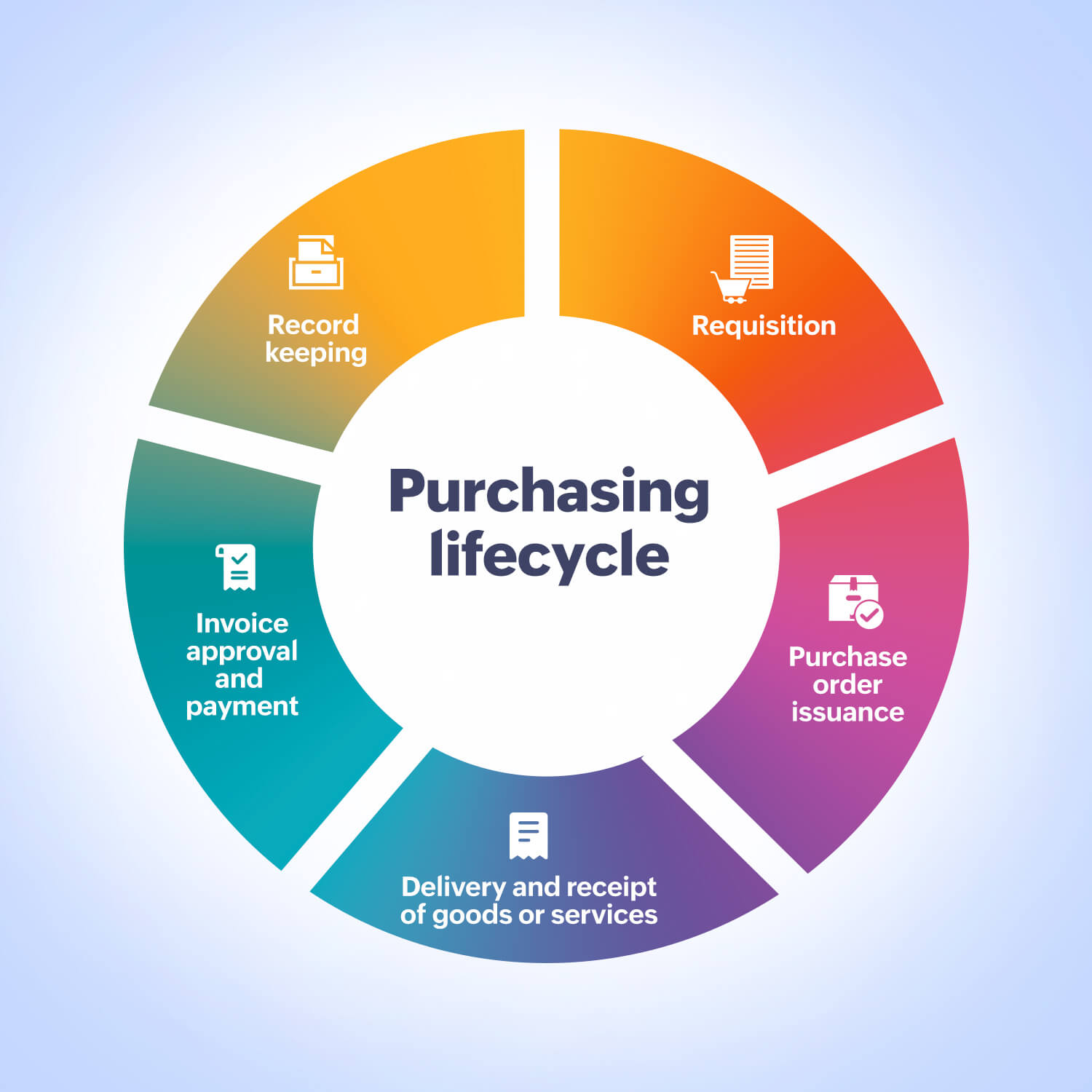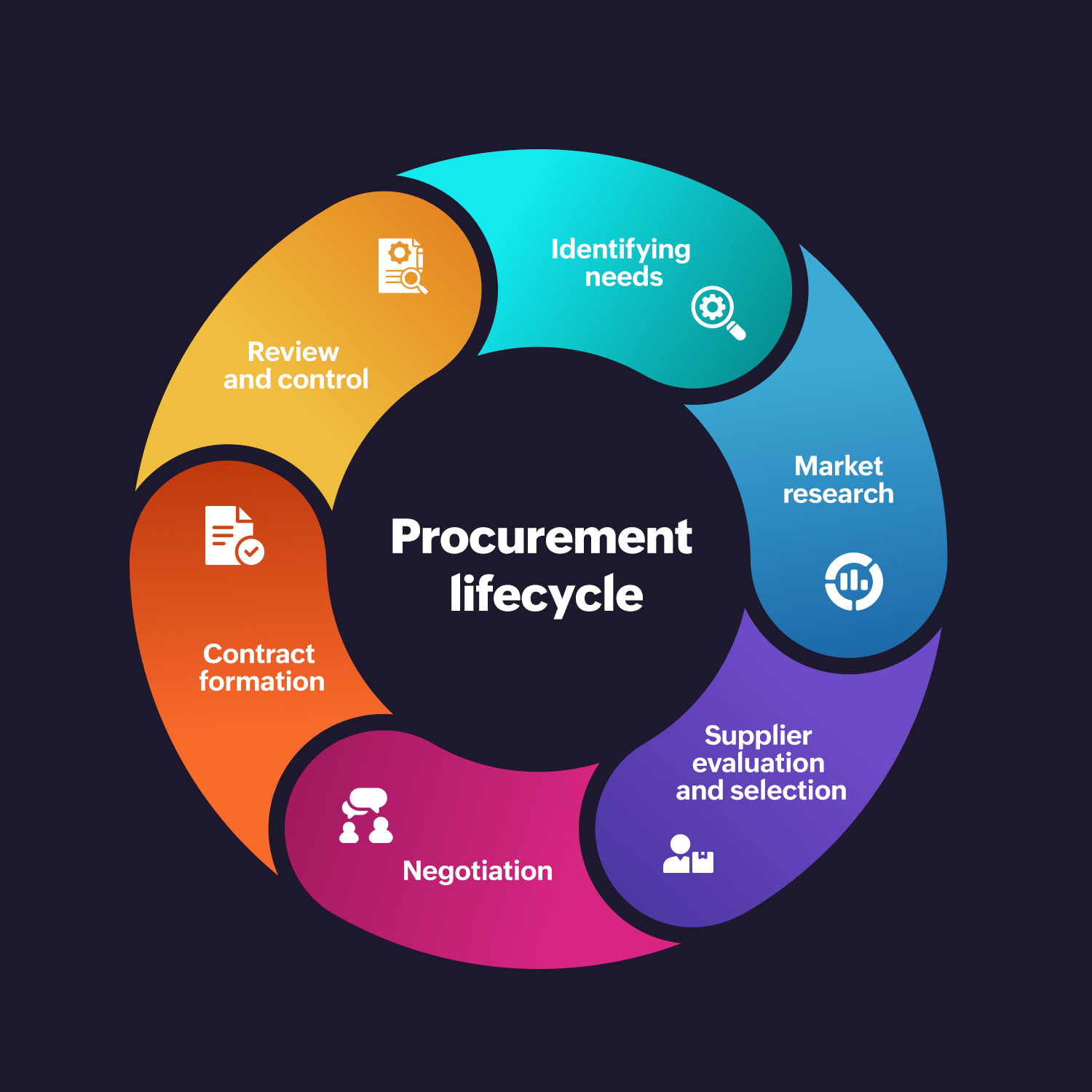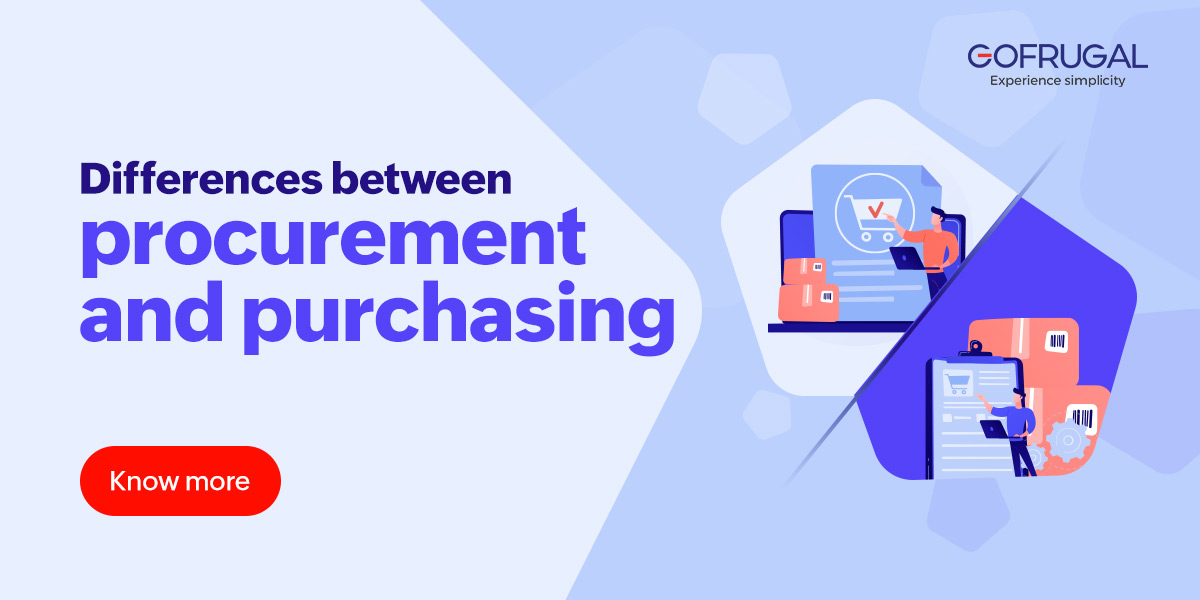Procurement is often confused with purchasing, leading to their interchangeable usage. Everyone thinks it is potato, pot-ah-to, but it's not. These two functions are distinctly separate in their objectives, scope of tasks, personnel involved, and most notably, their outcomes.
Though these terms seem synonymous, when you dig deep, you'll understand the stark disparities between the two. While some organizations may favor one term over the other, neglecting to grasp the fundamental differences between purchasing and procurement can result in overlooking critical components that could impact an organization's financial performance. No one wants that! Learn the difference between procurement and purchasing in this short guide.
Contents
- What is procurement?
- What is purchasing?
- Key differences between procurement and purchasing
- Examples of procurement and purchasing
- Procurement vs. purchasing lifecycle
- Purchasing lifecycle
- Procurement lifecycle
- How Gofrugal helps with procurement and purchasing
- Procurement or purchasing: Which is the winner?
What is procurement?
Procurement is more than just buying goods and services; it's a strategic process including the acquisition of resources necessary for business operations. Unlike purchasing, which focuses on transactional activities, procurement involves strategic planning, supplier relationship management, and risk mitigation. At its core, procurement aims to optimize costs, enhance quality, and ensure timely delivery to meet organizational objectives.
What is purchasing?
Purchasing, on the other hand, is a subset of procurement, concentrating on the transactional aspects of acquiring goods and services. It involves activities such as requisition, sourcing, ordering, receiving, and payment. While procurement sets the overarching strategy, purchasing executes the tactical aspects, negotiating contracts, managing orders, and maintaining supplier relationships to fulfill operational needs efficiently.
Key differences between procurement and purchasing
To grasp the differences between procurement and purchasing even better, consider their fundamental differences.
- Scope: Procurement is all about strategic planning, supplier selection, and contract management, whereas purchasing focuses on transactional activities such as ordering and payment processing.
- Objective: Procurement aims to optimize costs, mitigate risks, and foster innovation, while purchasing is primarily concerned with fulfilling immediate operational needs at the lowest possible cost.
- Timeline: Procurement involves long-term strategic planning and relationship building, while purchasing operates within shorter timeframes, focusing on timely acquisition and delivery of goods and services.

Examples of procurement and purchasing
Here is an interesting example to help you further understand the difference between procurement and purchasing.
Procurement
Imagine a large retail chain looking to source inventory for its stores. The procurement team conducts extensive market research to identify potential suppliers of various products, including clothing, electronics, and household items. They analyze market trends, negotiate contracts, and establish strategic partnerships with suppliers to ensure competitive pricing, high-quality products, and timely delivery.
For example, the procurement team may negotiate a long-term contract with a clothing manufacturer to supply a range of apparel items for the upcoming season. They collaborate with the supplier to design customized products, establish pricing agreements, and coordinate logistics to ensure the seamless delivery of merchandise to stores nationwide. Through strategic procurement practices, the retail chain can optimize costs, maintain product quality, and enhance customer satisfaction.
Purchasing
Once the procurement strategy is in place, the purchasing team executes the plan by placing orders for specific products based on store demand and inventory levels. They generate purchase orders, communicate with suppliers, and coordinate shipments to ensure stores have an adequate supply of merchandise to meet customer needs.
For example, the purchasing team may place orders for replenishment stock of popular electronics, such as smartphones or laptops, based on sales data and inventory forecasts. They work closely with suppliers to schedule deliveries, track shipments, and resolve issues that may arise during the procurement process. By efficiently managing purchasing activities, the retail chain can minimize stockouts, optimize inventory levels, and maximize sales revenue.
Procurement vs. purchasing lifecycle
Understanding the comprehensive lifecycle of procurement and purchasing clarifies their distinct functions and impacts on businesses. Each phase of the "Procurement vs. Purchasing" journey has specific activities outlined here.
Purchasing lifecycle

- Requisition: Identification of the need for a product or service.
- Purchase order issuance: Formal placement of an order with the supplier.
- Delivery and receipt of goods or services: Reception and inspection of ordered goods or services for quality and quantity.
- Invoice approval and payment: Verification, approval, and payment of the supplier's invoice.
- Record keeping: Documentation of transaction details for future reference.
Procurement lifecycle

- Identifying needs: The initial step where an organization determines and quantifies its requirements.
- Market research: Surveying the market for potential suppliers capable of meeting these needs.
- Supplier evaluation and selection: Evaluation of suppliers based on criteria such as price, quality, delivery time, and post-purchase service, followed by selection of the most suitable ones.
- Negotiation: Negotiating the price, delivery, and payment terms with the chosen suppliers.
- Contract formation: Drafting a formal contract encompassing all agreed terms and conditions.
- Review and control: Continuous monitoring of supplier performance post-contract, with necessary corrective actions implemented as needed.
How Gofrugal helps with procurement and purchasing
Technology plays a pivotal role in distinguishing between "procurement" and "purchasing." Choosing the right tech will help you handle both procurement and purchasing in the right approach. Here is how Gofrugal's software can help you.
- Centralized procurement: Streamline the procurement process from requisition to payment to reduce errors and maximize accuracy.
- Supplier management: Businesses can build strong supplier relationships with Gofrugal by accessing supplier reviews and facilitating transparent communication.
- Standard policies: Enable the definition and enforcement of standard procurement policies to ensure clarity and consistency.
- Advanced planning: With Gofrugal's ERP system, businesses can plan and procure in advance based on insightful reports and stock audits.
- Automation: Automate procurement touchpoints to minimize manual errors and streamline processes for improved efficiency.
- Digitized purchase system: Make informed purchasing decisions by digitizing the entire purchase process to ensure the right products are sourced at the right time and price.
- Efficient operations: With Gofrugal, businesses can execute purchases with minimal staff and minimal technical skills required, leading to streamlined operations and improved profitability.
- AI and ML automation: Gofrugal's AI and ML automation capabilities help forecast customer demands accurately, optimize procurement for maximum profits, and achieve precise gross margin return on investment (GMROI).
- Cost savings: Businesses can save up to 1% on turnover within the first three months of using Gofrugal thanks to complete visibility and control over the purchase-to-purchase return process.
- Optimized inventory management: Our reordering system uses over 10 parameters to ensure businesses operate with a lighter inventory, reducing costs and improving efficiency. Additionally, the mobile-based three-way PO reconciliation system speeds up inventory replenishment by 60%.
Check out our blog, top six procurement challenges and the solutions to overcome purchasing problems, for more information on this subject.
Procurement or purchasing: Which is the winner?
In the debate between procurement vs. purchasing, there is no clear winner. Companies must select an approach tailored to their specific requirements. Small businesses might opt for purchasing to maintain a streamlined and straightforward process, while larger enterprises may prioritize a comprehensive procurement process to integrate it into their corporate strategy. Both play integral roles in driving organizational success, with procurement setting the strategic direction and purchasing executing tactical activities. By synergizing procurement's strategic vision with purchasing's operational efficiency, businesses can achieve cost savings, mitigate risks, and enhance competitiveness in the mLearn the difference between procurement and purchasing. Navigate complexities, avoid pitfalls, and see how Gofrugal streamlines procurement and purchasing.

